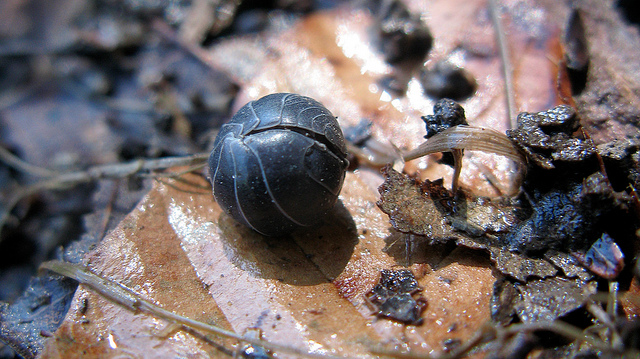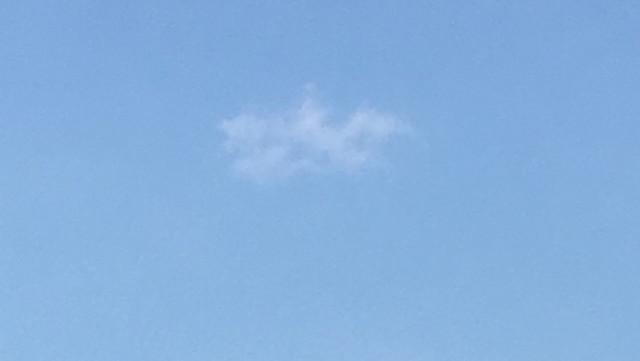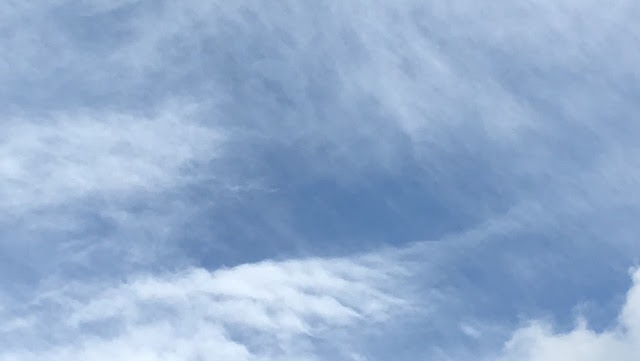The Poetry Section is edited by Mark Bibbins.
Consider The Roly Poly

Life hides in small places. Turn over a wet rock and you’ll find a few roly poly bugs doodling paths through the soil. Poke one, and it’ll curl up its armored body into a ball. And the thing is—even though roly polies live a bug-like existence, they’re not bugs at all, they’re land crustaceans, related to shrimp, brine shrimp (Sea-Monkeys®), krill, crabs, crayfish, lobsters, and other marine arthropods with two-branched limbs and segmented bodies.
Stretched out to its full walking length, a roly poly is about the size of an Ibuprofen caplet. When startled, a roly poly will curl itself into a pill-like ball—a Claritin D if it’s a baby, and Tylenol pill if it’s an adult. This curling-up action is called conglobation. Roly polies conglobate as a protective measure, as well as to retain moisture. If they dry out, they die. And if they’re fully immersed in water, they die. If not for their ability to roll up into a cute little ball, which makes them endlessly fascinating to kids, a roly poly would be your run-of-the-mill creepy crawly, like an earwig or Paul Manafort.
Roly polies have grudgingly adapted to land. They live where few others can, noshing on harmful funguses that can add carbon dioxide to the atmosphere, in addition to devouring soils rich with heavy metals. Unlike marine crustaceans, whose gills distribute gases throughout the bloodstream and body, land crustaceans have spongy gills that store oxygenated water inside their bodies as they gulp down mulch. In essence, a roly poly is a Sea-Monkey® that doesn’t have its shit together, and only a creature as small as a roly poly could make that into a feature instead of a flaw.
Dynamite with a Laser Beam

Image: Wikimedia Commons
Sputnik launched the Space Race and shamed a man onto the moon, but what it rarely gets credit for is birthing an art form: the psychedelic laser light show. In its wake, the US government funded hundreds of planetaria, many more than anyone needed or wanted. To compete with free love and color TV, these surplus domes were forced to diversify their programming. Enter Pink Floyd, and generations of weed-reeking teens.
This at least is how Dave McCullough tells it, and he’s basically the grandaddy of the whole laser-Floyd phenomenon. In 1970, McCullough was president of Audio Visual Imagineering, a brash upstart on the national laser scene. They’d just landed a plum contract with the Hayden Planetarium, at the Museum of Natural History in New York, where it was McCullough’s intention to blow minds—specifically those minds deadened to the splendors of his craft through prolonged exposure to Laserium, his predecessors at the Hayden. “The thing about laser shows back then,” he told me over the phone, “is most were infantile. They were just dumb.”
Laserium had been content to toss on a pop song and shoot random squiggles at the sky. Not McCullough. For AVI’s first show at the Hayden, he pioneered a new mode of laser-based expression: The Floyd songs were actually synced with the lasers, and for the first time these lasers merged to form images, rudimentary cartoons. The big-city Boomers ate it up, as did their counterparts in the provinces, whose formative experiences, enshrined in retro books and sitcoms, would lodge the Floyd show between the Tastee Freeze and Tunnel of Love in the country’s collective pop-cultural unconscious.
Cut Copy, "Standing In The Middle Of The Field"
Will SoundCloud die? I have no idea, but given the way everything has gone thus far this year I wouldn’t put much money on the chance of one of the few things that is actually good about the Internet surviving. Anyway, here’s something new from Cut Copy. Listen to it now before SoundCloud disappears, which could be as early as the end of the day. Enjoy, it may be the last time.
New York City, August 9, 2017
 ★★★★ A little haze floated above the bright and warm morning, to keep expectations from going completely wild. By the middle of the day, though, the facts were in. People lingered against the buildings, working their phones. Bicycles and pedestrians were going in all directions, at all speeds. Grill smoke rose from a trailer parked on a corner by Broadway. A vendor sold mango from a wheeled shopping basket; a mailman in a uniform t-shirt at an ice cream cone on the sidewalk, standing beside his mail cart. The air in the shade of the cross streets was simultaneously warming and bracing. Trumpet vines swung in the wake of a passing U-Haul.
★★★★ A little haze floated above the bright and warm morning, to keep expectations from going completely wild. By the middle of the day, though, the facts were in. People lingered against the buildings, working their phones. Bicycles and pedestrians were going in all directions, at all speeds. Grill smoke rose from a trailer parked on a corner by Broadway. A vendor sold mango from a wheeled shopping basket; a mailman in a uniform t-shirt at an ice cream cone on the sidewalk, standing beside his mail cart. The air in the shade of the cross streets was simultaneously warming and bracing. Trumpet vines swung in the wake of a passing U-Haul.
Thick As A Rain of Blows

A year or so ago there was a spate of explainer articles asking: “is Donald Trump a fascist”? The answers ranged from scholarly equivocations to frenzied rants on the impending Trumpian Third Reich. Even with the work of countless writers, theorists and academics who have studied fascism in minute historical detail, the answers to why these political movements (or specters of them) arise remain unsatisfying. A detailed study of historical documents and key figures will not reveal the reasoning of the individuals involved. “Reason,” in this case, will betray the historian, because fascism itself is a mockery of reason.
One relatively obscure scholar of fascism, in his own extremely unorthodox way, offers a compelling thesis on the persistent question of “why” fascism happens. The German writer and academic Klaus Theweleit, writing in the 1970s, suggests that fascism can be best understood through the fascists own words. He presents his argument as a kind of collage, both in form and content. His text includes hundreds of images, from vulgar Robert Crumb comic strips, to postcards and propaganda posters, to paintings, engravings and murals of nude women from all eras of art history.
The core of his text is rooted in the journals, autobiographies and novels of freikorps members, but he also borrows widely from the culture of the time, expertly using snippets of famous poems and novels from German literature, as well as the work of psychoanalysts like Freud and Wilhelm Reich, to piece together a terrifying picture of the fascist subconscious. What these texts reveal, according to Theweleit, are a kind of bizarre psychosexual politics, rooted in psychological repression, violence and, most importantly, fear of the feminine.
How To Have A Big Crush On The Violin
 Every week, I struggle not to write about friend of the column Camille Saint-Saëns. I’m not quite sure why! He’s by no means my favorite composer, but his work has always had an odd staying power for me. Perhaps it’s because in my years as a musician, I found myself playing his work the most. It never made much sense to me at the time: shouldn’t students of classical music be concerning themselves with Beethoven and Mozart and Tchaikovsky around Christmastime? But no, time and time again, I found ol’ C-C S-S’s name plopped down onto my music stand.
Every week, I struggle not to write about friend of the column Camille Saint-Saëns. I’m not quite sure why! He’s by no means my favorite composer, but his work has always had an odd staying power for me. Perhaps it’s because in my years as a musician, I found myself playing his work the most. It never made much sense to me at the time: shouldn’t students of classical music be concerning themselves with Beethoven and Mozart and Tchaikovsky around Christmastime? But no, time and time again, I found ol’ C-C S-S’s name plopped down onto my music stand.
I get it now (mainly because I’m old): Saint-Saëns’ music is the classical (or, well, Romantic, but still) music you give to someone who doesn’t know whether or not they like classical music. No doubt there’s value in so many composers, but for the truly uninitiated, Saint-Saëns’ music is capable of bringing such light and color that it becomes impossible to turn away. And in light of writing last week about the piece that made me fall in love with the cello, here’s the piece that made me fall in love with the violin: Introduction et Rondo capriccioso (Itzhak Perlman, 2012).
A Poem by Alane Lim
After the Fall
In summer, the mushrooms and moss
dusted the forest floor in colors
from white to oxblood violet,
singles and clusters
that blossom among the bric-a-brac
here and there with no order to them,
as when gardeners averse
to arrangement toss the seeds
of rose and larkspur towards nowhere,
towards everywhere à la joie de vivre.
You characterized the forest like this,
like the world was streams of magic and ether.
I was skeptical, listening half intently unless it was wintertime;
hot chocolate and cold worked wonders.
It makes sense now, I think. It is autumn.
Here, beloved, I held you last
during that interregnum of warmed seasons,
when cool rains falsified the first fallings of late December.
The ground is paved with leaves, fog, and the fantastical
and I think of the stories I have forgotten already,
as though I ever knew them.
The seasons are no longer strange to me,
though the fall is more wintry than usual.
It is too cold, too cold for my visit.
I will wander the old ways for the last time,
spread a few leaves about as I exit
to create the myths anew again
in an array of orange, yellow, black, and brown.
Alane Lim is a materials science graduate student at Northwestern University, and a published science and satire writer. She has previously taken poetry classes at Johns Hopkins University. You can follow her on Twitter @thisisalane.
Ryuichi Sakamoto, "Andata" (Electric Youth Remix)
If you were surprised to learn that it’s actually Thursday today I wouldn’t blame you: This week—all weeks now—has already gone on so long that it’s a fool’s errand to keep track. All you can do is have faith that eventually it will come to an end, either because of simple chronology or the nuclear holocaust they keep promising. In any event, here is some music for the morning. Play it about 7000 times and it should get you to noon. Enjoy.
New York City, August 8, 2017
 ★★★★ Work backwards from the moment the sinking sun above the roofline of the apartment block merged with the reflection of the reflection of the sinking sun in the windows below it: the day was beautiful yet somehow out of joint. From a desk, near the workday’s end, it had seemed as if the daylight were palpably slipping off toward autumn and darkness; what was left after the commute, though, was still long and bright, till the clouds and the buildings blushed pink together. The sky was clear and simple only after it had been layered with clouds in complex profusion, the highest layer sliding by slowly and a little dizzyingly. People were out on Broadway in the no-traffic lanes, slumped at the tables there. A scaffold was coming down and the sun inside its frame hurt the eyelids. The more the humid morning breeze gusted, the softer and easier it felt.
★★★★ Work backwards from the moment the sinking sun above the roofline of the apartment block merged with the reflection of the reflection of the sinking sun in the windows below it: the day was beautiful yet somehow out of joint. From a desk, near the workday’s end, it had seemed as if the daylight were palpably slipping off toward autumn and darkness; what was left after the commute, though, was still long and bright, till the clouds and the buildings blushed pink together. The sky was clear and simple only after it had been layered with clouds in complex profusion, the highest layer sliding by slowly and a little dizzyingly. People were out on Broadway in the no-traffic lanes, slumped at the tables there. A scaffold was coming down and the sun inside its frame hurt the eyelids. The more the humid morning breeze gusted, the softer and easier it felt.

